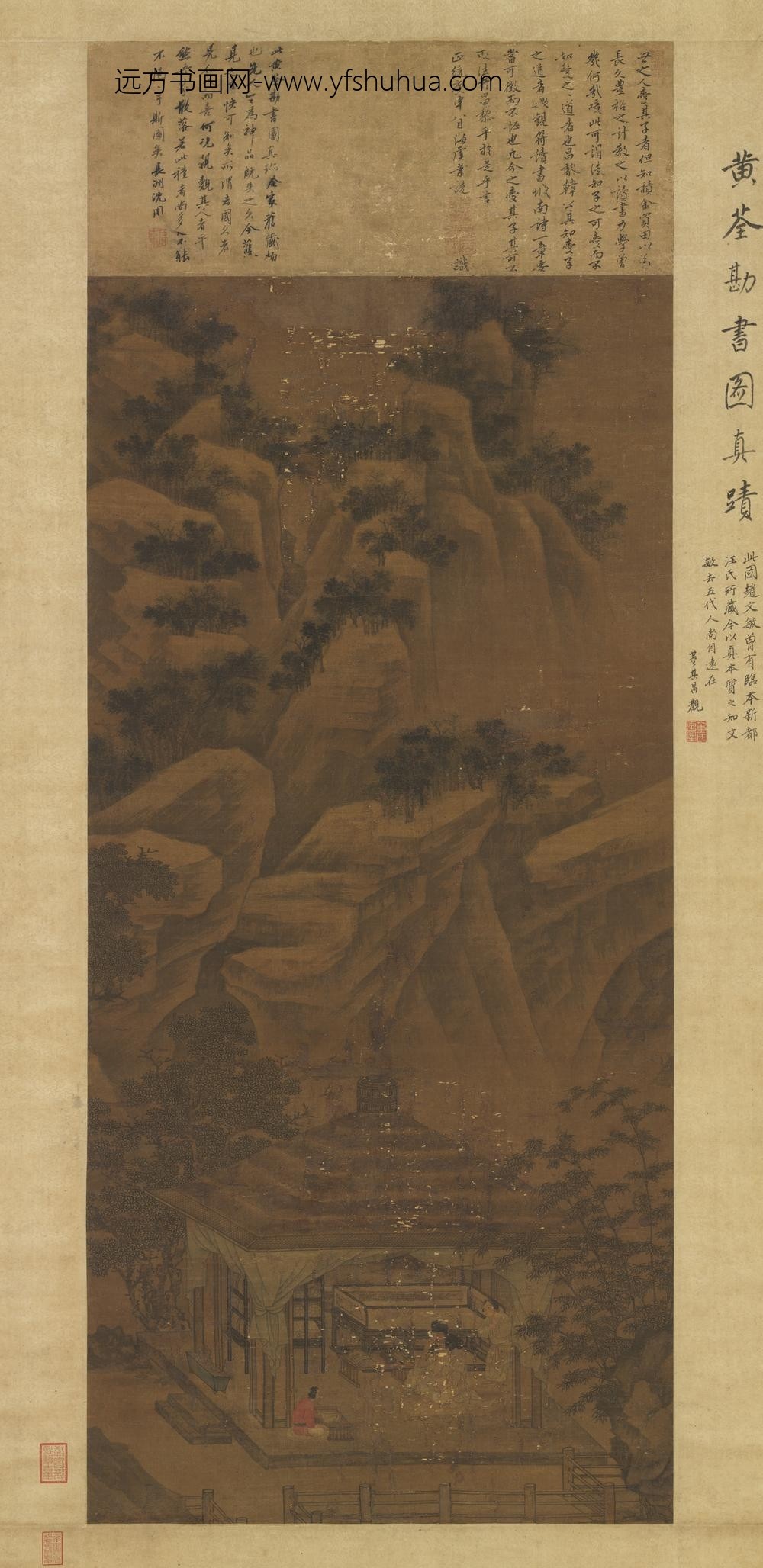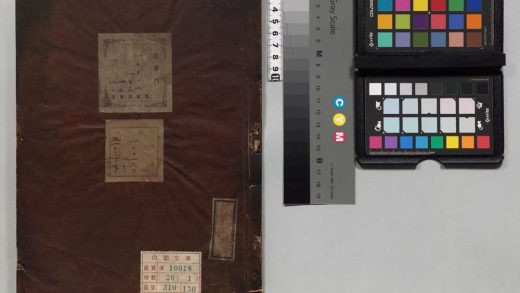【作品基本信息】
| 作者 | 黄筌(荃) |
| 品名 | 勘书图轴 |
| 朝代 | 五代十国前后蜀 |
| 文件大小 | 18.0MB |
| 分辨率(DPI) | 300×300 |
| 像素大小 | 1708×3513 |
| 尺寸(CM) | 14.46×29.74 |
| 作品数量 | 1 |
| 作品收藏 | 台北故宫博物院 |
| 图片格式 | 默认提供TIF和JPG两个版本 |
基本数据
| 藏品类型 | 绘画 |
| 品名 |
五代后蜀黄筌勘书图轴 The Reading Lesson |
| 分类 | 绘画 |
| 作者 | 黄筌 |
| 数量 | 一轴 |
典藏尺寸
| 【位置】 | 【尺寸】(公分) |
| 本幅 | 118.1×55.5 |
| 诗塘 | 22.1×55.5 |
| 【质地位置】 | 【质地】 |
| 本幅 | 绢 |
| 诗塘 | 绢 |
题跋数据
| 【题跋类别】 | 【作者】 | 【位置】 | 【款识】 | 【书体】 | 【全文】 |
| 题跋 | 叶诜 | 诗塘 | 正统庚申八月海虞叶诜识 | 世之人爱其子者。但知积金买田。以为长久丰裕之计。教之以读书力学。曾几何哉。噫。此可谓徒知子之可爱。而不知爱之之道者也。昌黎韩公。其知爱子之道者欤。观符读书城南诗一章。要当可征而不诬也。凡今之爱其子其可不取法于昌黎乎。于是乎言。正统庚申八月海虞叶诜识。 | |
|
印记: 己酉□□、(一印漫漶不可识) |
|||||
| 题跋 | 沈周 | 诗塘 | 长洲沈周 | 此黄筌勘书图真迹。余家旧藏物也。先人定为神品。既失之久。今获见之。其快可知矣。所谓去国久者。见仙人而喜。何况亲觌其人者乎。然吾家散落若此种者尚多。□不能不悒悒于斯图矣。长洲沈周。 | |
|
印记: 启南 |
|||||
| 题跋 | 董其昌观 | 裱绫 | 董其昌观 | 黄筌勘书图真迹。此图赵文敏曾有临本。新都汪氏所藏。今以真本质之。知文敏去五代人尚自远在。董其昌观。 | |
|
印记: 董氏玄宰 |
|||||
印记资料
| 【印记类别】 | 【印记】 |
主题
| 【主题类别】 | 【主题(第一层)】 | 【主题(第二层)】 | 【主题说明】 |
| 主要主题 | 山水 | ||
| 主要主题 | 建筑 | 斋馆 | |
| 主要主题 | 经史‧故事 | 勘书图(韩愈) | |
| 其他主题 | 人物 | 高士(士人、隐士) | |
| 其他主题 | 人物 | 孩童 | |
| 其他主题 | 人物 | 侍从(侍女、童仆) | |
| 其他主题 | 树木 | ||
| 其他主题 | 树木 | 竹 | |
| 其他主题 | 建筑 | 栏杆 | |
| 其他主题 | 器用 | 家具(屏风) | 榻、桌、椅、几 |
| 其他主题 | 器用 | 文房用具 | 书、笔、墨、纸、砚 |
技法
| 【技法】 | 【技法细目】 |
| 界画 | |
| 皴法 | |
| 人物衣纹描法(匀称线条) |
参考数据
| 【类别】 | 【参考数据】 |
| 收藏着录 | 故宫书画录(卷五),第三册,页29-30 |
| 收藏着录 | 故宫书画图录,第一册,页117-118 |
| 内容简介(中文) |
黄筌(约公元九O三—九六五年),事前蜀后主为待诏。黄筌传世作品以花鸟最多,山水颇少见。此幅图写韩愈深明爱子之道,唯教以读书之事。书法甚奇,沈周与董其昌之跋俱伪,以笔墨论,似为明代作品。 画中有案面两头翘起,两足为竖条组成的板式足,足下安托子,保留隋唐以来直栅足跗的遗意。坐榻体大厚重,足下有托泥,形成箱形榻体亦以壶门装饰。榻之三面以画屏装饰,屏风上绘墨竹。屋旁置有三层圆腿书籍架格。 |
| 内容简介(英文) |
Huang Ch’uan was a Painter-in-Attendance at the court of the Former Shu. Most of the surviving works attributed to him are birds-and-flowers, with landscapes exceptionally rare. This painting depicts Han Yu engaged in his favorite method of showing his love for his children–teaching them to do textual exegesis. Executed in an unusual style, this work bears false Ming (1368-1644) inscriptions by Shen Chou and Tung Ch’i-ch’ang. However, based on the use of brush and ink, it appears to date to the Ming dynasty. Depicted in this painting is a table with everted flanges and legs made from panels of wood. Stabilizer bars provide further support. This style follows in the post-T’ang tradition of vertical rods for legs. The box-shaped platform is large and heavy with ground stretchers and cusped openings. Three sides of the platform are decorated with low screen paintings depicting bamboo in monochrome ink, and next to the building is a three-level book rack with round legs. |
| 内容简介(中文) |
唐代韩愈为勉励儿子韩符勤奋向学,作〈符读书城南〉诗。诗中强调人之能为人,正因有学问,而学问唯靠勤劳获得;且人年幼时虽相彷佛,渐长时却因勤学与否而生殊异。此幅即图写韩愈深明爱子之道,教子以读书之事。 本幅传称黄筌(约公元九O三—九六五年)作。黄筌为五代前蜀后主待诏,作品多为花鸟,山水少见。本幅以笔墨论,或为明代作品。画上沈周与董其昌跋俱伪。(20091016) |
| 内容简介(英文) | Han Yu (768-824) of the Tang dynasty composed the poem “Fu’s Studies at Chengnan” to encourage his son, Han Fu, to study hard. The poem emphasizes that what makes a person is the ability to study texts, and such learning is only acquired through diligent practice. And though children grow up more or less the same, what makes some stand out is their diligence in study. This work depicts Han Yu’s great love for his child as he teaches him how to study, and it is attributed to Huang Quan (a Painter-in-Attendance at court who mostly did bird-and-flower subjects but few landscapes). The forms are outlined in brush and ink in what is probably a Ming (1368-1644) work. The Ming colophons by Shen Zhou and Dong Qichang here are also spurious.(20091016) |
| 参考书目 | 〈五代后蜀黄筌勘书图轴〉,收入国立故宫博物院编辑委员会、林莉娜主编《画中家具特展》(台北:国立故宫博物院,1996.10),页14-15、109。 |
【作品展示】

__五代后蜀黄筌勘书图.轴故画__KANPAA




